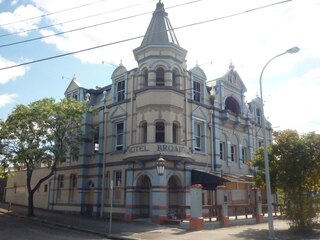
The Mansions is a heritage-listed row of six terrace houses at 40 George Street, Brisbane City, City of Brisbane, Queensland, Australia. It was designed by G.H.M. Addison and built in 1889 by RE Burton. It was added to the Queensland Heritage Register on 21 August 1992.

Petrie Terrace is an inner suburb of the City of Brisbane, Queensland, Australia.

Red Hill is an inner northern suburb in the City of Brisbane, Queensland, Australia. In the 2016 census, Red Hill had a population of 5,560 people.

Cook Terrace is a heritage-listed terrace house at 249 Coronation Drive, Milton, City of Brisbane, Queensland, Australia. It was built from 1888 to c. 1900. It is also known as Gloralgar Flats and Milton Terrace. It was added to the Queensland Heritage Register on 21 October 1992.

Old Bishopsbourne is a heritage-listed house at 233 Milton Road, Milton, City of Brisbane, Queensland, Australia. It was designed by Benjamin Backhouse and built from 1865 to 1959. It is also known as St Francis Theological College and Bishopsbourne. It was added to the Queensland Heritage Register on 21 October 1992.

Coronation Hotel is a heritage-listed hotel at 46 Montague Road, South Brisbane, Queensland, Australia. It was designed by Francis Drummond Greville Stanley and built in 1891. It is also known as Montague Hotel. It was added to the Queensland Heritage Register on 30 April 1993.

Broadway Hotel is a heritage-listed hotel at 93 Logan Road, Woolloongabba, City of Brisbane, Queensland, Australia. It was designed by John Hall & Son and built from 1889 to c. 1942 by Wooley & Whyte. It was added to the Queensland Heritage Register on 21 October 1992. The building has been in a state of significant disrepair and neglect for several years, covered in graffiti and broken panelling, and in September 2018 was destroyed by a fire.

Norman Hotel is a heritage-listed hotel at 102 Ipswich Road, Woolloongabba, City of Brisbane, Queensland, Australia. It was designed by John Beauchamp Nicholson and built from 1889 to 1890. It was added to the Queensland Heritage Register on 12 July 2005.
John Beauchamp Nicholson was an architect in Brisbane, Queensland, Australia. A number of his works are heritage-listed.

Taylor–Heaslop Building is a heritage-listed commercial building at 10-14 Logan Road, Woolloongabba, City of Brisbane, Queensland, Australia. It was designed by John Beauchamp Nicholson and built from 1889 to 1890. It is also known as Ernest Reid (draper), John Evan's Cash Draper, George Logan Draper, Johns & Co Draper, People's Cash Store (grocers), JR Blane, and Moreton Rubber Works. It was added to the Queensland Heritage Register on 6 February 2006.

Sandgate Post Office is a heritage-listed former post office at 1 Bowser Parade, Sandgate, City of Brisbane, Queensland, Australia. It was designed in the office of the Queensland Colonial Architect and built from 1886 to 1887. It is also known as Sandgate Post and Telegraph Office. It was added to the Queensland Heritage Register on 7 February 2005.

Warriston is a heritage-listed duplex at 6-8 Musgrave Road, Red Hill, City of Brisbane, Queensland, Australia. It was built c. 1886. It is also known as Berley Flats. It was added to the Queensland Heritage Register on 21 October 1992.

The Normanby Fiveways is the intersection of five major roads to the north-east of the Brisbane central business district, Queensland, Australia.

St Brigid's Convent is a heritage-listed Roman Catholic convent at 9-17 Upper Clifton Terrace, Red Hill, City of Brisbane, Queensland, Australia. It was designed by Eaton & Bates and built from 1902 to 1923. It is also known as Convent of the Annuciation and Red Hill Convent. It was added to the Queensland Heritage Register on 28 March 2003.

Petrie Terrace Police Depot is a heritage-listed former police barracks at 25-61 Petrie Terrace, Petrie Terrace, City of Brisbane, Queensland, Australia. It was built from 1850s to 1960s. It was added to the Queensland Heritage Register on 23 July 1999.

Kelvin Grove Fig Trees and Air Raid Shelter are heritage-listed trees and air raid shelter at 176 Kelvin Grove Road, Kelvin Grove, City of Brisbane, Queensland, Australia. It was built from c. 1909 to 1942. It was added to the Queensland Heritage Register on 31 May 2005.

Inchcolm is a heritage-listed former office building at 73 Wickham Terrace, Spring Hill, City of Brisbane, Queensland, Australia. It was designed by Eric P Trewern and built in 1930 by J I Green & Son. It was converted into a hotel in 1998, and renovated in 2014. It now trades as Ovolo Inchcolm under the Ovolo Hotels Group. It was added to the Queensland Heritage Register on 23 March 1998.

Ballow Chambers is a heritage-listed office building at 121 Wickham Terrace, Spring Hill, City of Brisbane, Queensland, Australia. It was designed by Lange Leopold Powell and built from 1924 to 1926 by John Hutchinson. It was added to the Queensland Heritage Register on 21 October 1992.

Harris Terrace is a heritage-listed terrace house at 68 George Street, Brisbane City, City of Brisbane, Queensland, Australia. It was designed by J & G Cowlishaw and built from c. 1866 to c. 1867 by Mr Clarke. It is also known as Harris Court. It was added to the Queensland Heritage Register on 21 October 1992.

Buranda State School is a heritage-listed state school at 24 Cowley Street, Woolloongabba, City of Brisbane, Queensland, Australia. It was designed by Department of Public Works (Queensland) and built from 1920 to 1928. It was added to the Queensland Heritage Register on 28 April 2017.






















